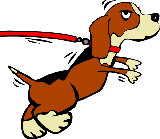Dog SuppliesThe Importance Of Using A Crate For Your Dog |
|
|
Though many new dog owners are initially horrified at the prospect of using a crate for their puppies, their attitude changes once they understands the use of it from a dog's perspective. All canines are den animals; they naturally seek out spots for rest that are sheltered and secure. This is why family dogs often lie under dining room tables, underneath beds, or in dark closets: they are simply following a deep-seated den instinct. By using a crate, you provide your puppy with his own den that would be his sanctuary. This is why house-training with a crate is highly recommended. A puppy kept in his den for a reasonable length of time, which is no more than three hours at a time during the day, will refrain from soiling and will learn to hold himself until you let him out. Consistently doing this helps your pup quickly acquire a regular schedule for elimination. In addition, crates prevent young puppies from getting into mischief when you cannot watch them and confines their chewing to objects you have provided. Also, crates are ideal for transporting your puppy by car, keeping him safe from sudden stops and swerves. There will always be times when you will not be able to supervise your pup. Having a crate simplifies these situations and provides him with a spot that he will always be comfortable in because it is familiar. It is crucial to introduce your pup to the crate gradually. Go out of your way to make his first experience with this a pleasant one. Start by placing an old blanket over the floor of the crate. Do not force a puppy in, shut the door, and leave during the first session. Instead, allow him to explore around the crate. Place several pieces of kibble in the crate as your pup watches. If he goes into the crate after the food, praise him enthusiastically. If not, gently lift the pup up and place him inside the crate, without shutting the door. You can pet him if he needs reassurance. Next, call the puppy out and praise him when he comes to you. Repeat this process for several minutes. If your pup shows no signs of disturbance, try closing the door for a minute. Finish the session by opening the door and praising him. The next time you feed your pup, feed him inside the crate, luring him inside with his food bowl, and then close the door. When he finishes, your pup may start whining and barking to get out. Firmly striking the front of the cage door with your hand, and saying "No" in a deep voice should discourage this. Wait for your pup to be quiet for five minutes before opening the door and escorting him out to his soiling area to eliminate. As your puppy becomes comfortable with the crate, you can increase the time that he spends there. Back to the Dog Supplies page
| |
|
Related News About Dogs ' ); // get rid of newsfeed display by carp CarpConf('poweredby',''); CarpCacheShow('http://dogguidance.com/dogblog/feed'); ?>
|
|
|
|
|
|
Copyright © 2006-2007 dogguidance.com |


